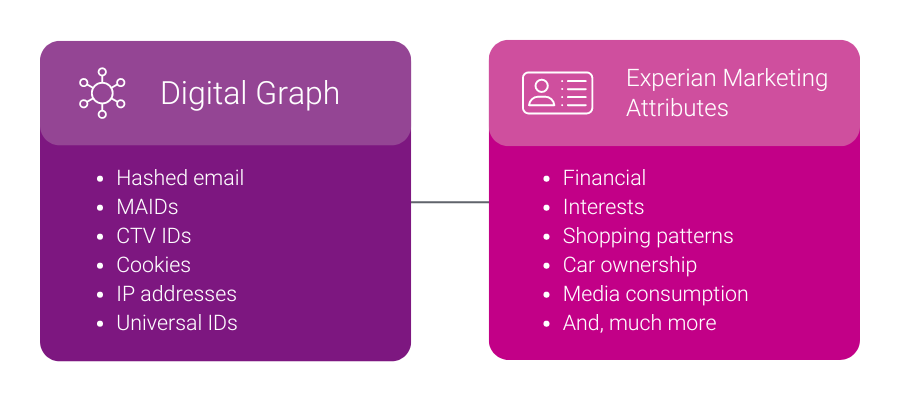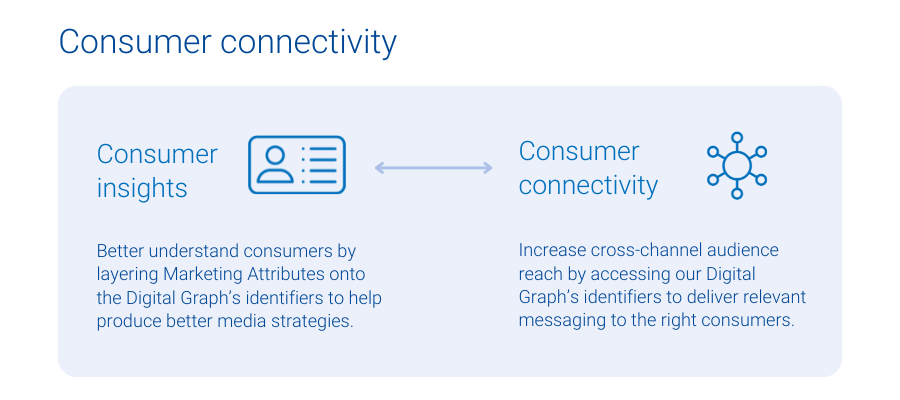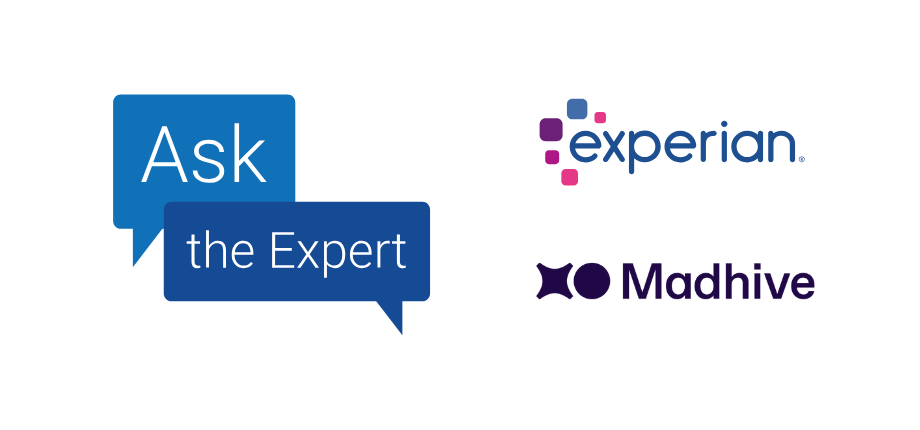
Experian, the leader in powering data-driven advertising through connectivity, is thrilled to unveil our latest solution, Digital Graph and Marketing Attributes. This joint solution supplies marketers and platforms with the insights and connectivity needed to understand who their customers are and reach them across digital channels.
The uncertainty around third-party cookies in Chrome and the overall decline in signal complicates the industry’s ability to reach the right consumer. Omnichannel media consumption results in scattered data, making it harder for marketers and platforms to understand consumer behavior and reach them across channels. These challenges call for a comprehensive solution.
Our Digital Graph and Marketing Attributes solution addresses these challenges by providing identifiers for seamless cross-channel engagement. By adding Marketing Attributes, like demographic and behavioral data, marketers and platforms also gain a better understanding of their customers. This solution uses Experian’s Living Unit ID (LUID) to combine offline and digital data, giving customers deeper insights into consumer behavior, greater audience reach, and improved cross-channel visibility.

Benefits of Digital Graph and Marketing Attributes
Both our Digital Graph and Marketing Attributes provide value to clients as standalone products. When clients license our Digital Graph and Marketing Attributes joint solution, they have more data at their fingertips, unlocking:
- Consumer connectivity: When clients license Experian’s Digital Graph, they get access to digital identifiers like mobile ad IDs (MAIDs), connected TV (CTV) IDs, hashed emails (HEMs), and universal IDs so they can target the right consumers with the relevant messages across all digital media channels.
- Consumer insights: Experian’s 5,000 Marketing Attributes provide our clients with detailed consumer information and insights, such as age, gender, purchase behaviors, and content consumption habits. Marketing Attributes help clients create more relevant messaging and informed audience segmentation.

Client examples
How OpenX offers richer targeting and more connectivity with Experian
OpenX is an independent omni-channel supply-side platform (SSP) and a global leader in audience, data, and identity-targeting. With industry-leading technology, exceptional client service, and extensive scalability across all formats, including CTV, app, mobile web, and desktop, OpenX has a legacy of innovating products that enhance buyer outcomes and publisher revenue while addressing complex challenges in programmatic.
In recent years, OpenX has licensed Experian’s Digital Graph with identifiers, contributing to the SSP’s largest independent supply-side identity graph, which offers advanced audiences to buyers and improved data resolution to content owners.
More recently, OpenX licensed Experian’s Marketing Attributes to enrich its supply-side identity graph, which includes IPs, MAIDs, and client IDs, with a variety of attributes. This strategic move has helped OpenX’s clients benefit from enhanced consumer insights and addressability, in turn delivering greater reach to the demand side and higher revenue for publishers, despite industry signal loss.
“We built on our long-term partnership with Experian to enrich our digital IDs with Experian’s Marketing Attributes, which help provide buyers better insights to audiences, thereby helping our publishers monetize their inventory. With partners like Experian, OpenX effectively facilitates the value exchange between demand and supply, ensuring our partners are able to drive results for their business in the era of signal loss”
Craig Golaszewski, Sr. Director of Strategic Partnerships, OpenX
How StackAdapt licenses our product bundle to address three different use cases
StackAdapt is the multi-channel programmatic advertising platform trusted by marketers to deliver exceptional campaigns. They drive superior results through a variety of solutions, like contextual and first-party targeting, brand lift measurement, and optimization through insights.
StackAdapt licensed a similar yet unique product combination, our Digital Graph and our Audiences. StackAdapt uses the Digital Graph to allow clients to onboard their first-party data in a seamless, self-serve manner that allows them to further segment their data using Experian Audiences.
“StackAdapt has been recognized as the most trusted programmatic platform by marketers, and with the integration of Experian’s Digital Graph and Audiences, we are strengthening our leadership in the space. This partnership improves our ability to deliver precise cross-channel segmentation, reach, and measurement, helping advertisers run more successful campaigns. Our collaboration with Experian allows us to offer a differentiated solution in the market and ensure our clients can deliver the most precise and impactful ads to their audiences.”
Denis Loboda, Senior Director of Data, StackAdapt
We recently announced a new partnership with StackAdapt. This collaboration brings the power of Experian’s identity graph, syndicated and custom audiences directly to the StackAdapt platform. Read the full details in our press release here.
Four ways to use Digital Graph and Marketing Attributes
When these two products come together, our clients have a 360-degree view of their consumers, which helps them power four critical use cases:
- Analytics and insights: Learn more about your consumers by connecting our Marketing Attributes with our Digital Graph’s identifiers. For example, a retailer can discover that their recent customers over-index as pickleball fans and players, leading the retailer to sponsor a professional pickleball event.
- Inventory monetization: When supply-side partners know their audience better, they can attract advertisers in search of that audience. For example, a publisher might find out that their audience is full of pickleball fans, leading them to reach out to brands that want to reach this audience.
- Activation: Companies with access to more digital identifiers from our Digital Graph can reach more people, while controlling frequency across channels. A company might know that they want to reach pickleball fans. Now, they have the digital identifiers needed to reach pickleball fans across all digital channels where they consume content, leading to increased reach.
- Measurement and attribution: Use the Digital Graph’s support for various digital identifiers to understand all consumer touchpoints, from media impressions to conversions. Then, lean on our Marketing Attributes to determine who your messaging resonated with. For example, a company uses our Digital Graph to know if it was the same individual who was exposed to an ad on CTV and converted via e-commerce. On top of that, the company can use our Marketing Attributes data to find out that the people who purchased were overwhelmingly pickleball fans.
Connect with us to learn more about how our Digital Graph and Marketing Attributes joint solution can provide the data and insights you need to create, activate, and measure cross-channel media campaigns.
Get in touch with us
Latest posts

Identity-led local advertising that works Local advertisers run on tight budgets, short timelines, and constant pressure to prove what works. Every dollar must count. In this Ask the Expert session, Aaron Brown, Chief Scientist at Madhive, joins Ali Mack, VP of AdTech Sales at Experian, to discuss how the Maverick AI platform helps local advertisers make confident decisions, act on clear recommendations, and see outcomes they can stand behind. Why local campaigns demand accuracy, and how to deliver it Local teams juggle multiple channels, changing budgets, and heavy performance expectations. To stay competitive, local teams need quick answers to three critical questions: Which households are most valuable to reach? Which channels work best in their market? Are campaigns on on track, day by day? Delivering that level of accuracy means working from a single, trusted view of households, channels, and performance, powered by clean, connected, and continuously updated data. “When you think about local, these aren’t enormous budgets. These businesses depend on success from day one and are still finding their footing. There’s a wealth of nuanced information we need to hear from advertisers to ensure their campaigns succeed, and a wealth of insights we need to deliver back. It’s a real-time matching problem at scale to make sure everything runs profitably for our customers.”Aaron Brown, Chief Scientist Why Experian data is the foundation of local planning Data is the foundation of effective local advertising, but not all data is created equal. For local advertisers, the real advantage comes from high-quality, actionable data that pinpoints likely customers and reduces wasted spend. Experian Marketing Data provides the identity and insights spine that helps local advertisers: Identify the right households in each market Build consistent, people-based audiences across partners Activate with confidence and measure outcomes on the same foundation Madhive’s data marketplace builds on this identity layer, curating trusted data sets that advertisers can integrate directly into planning and activation. “We’re focused on creating perfect matches between businesses and consumers. The right data is critical, which is why we started the data marketplace. It’s a curated, opinionated take on the best data to drive outcomes for the companies that depend on us.”Aaron Brown, Chief Scientist Madhive's Maverick AI at the core of local advertising Madhive’s Maverick AI is the AI-powered operating system for local media. Built as a foundational layer behind Madhive’s entire workflow, Maverick AI connects the dots across planning, targeting, reporting, and storytelling. Its purpose is simple yet transformative: turn fragmented data and advertiser inputs into actionable insights at scale. What makes Maverick AI different? AI-driven intelligence It doesn’t just automate tasks; it analyzes signals, connects context across markets, and refines strategies as campaigns progress. Data connectivity Maverick AI integrates diverse data sources, including Experian’s trusted identity data, so local advertisers can target households with accuracy and measure outcomes confidently. Interactive transparency Beyond dashboards, Maverick AI works alongside sellers and advertisers, surfacing insights, flagging missing inputs, and turning transparency into clear next steps. Adaptability From structured KPIs to unstructured signals like lists of recent in-store buyers or priority ZIP codes, Maverick AI uses every clue to inform smarter, faster decisions. "Maverick AI exists to connect local advertisers with data like Experian’s. Its ability to collaborate and tell stories back to advertisers is one of its greatest strengths.”Aaron Brown, Chief Scientist How Maverick AI and Experian Marketing Data turn transparency into results Maverick AI turns performance transparency into aligned plans and faster optimizations for local advertisers and agencies. Paired with Experian’s identity data, advertisers get an accurate, household-level view of real people in real locations. That lets them build consistent local audiences, reach those audiences across connected television (CTV), social, and the open web, and confidently tie ad exposure back to outcomes that matter in each market. “Maverick AI is the foundational layer behind all our operations – targeting, reporting, and storytelling. It connects data across organizations and advertisers, including trusted data sources like Experian. AI works tirelessly to pick up context, connect the dots, and deliver great results end-to-end for our customers.”Aaron Brown, Chief Scientist Your next local campaign starts with Madhive and Experian Local advertising performance starts with a trusted identity foundation. With Experian data and Madhive’s Maverick AI platform, local advertisers can define the right households once, activate their campaigns across CTV and digital channels, and measure outcomes with confidence. Many brands are increasing investment in AI-powered planning to cut waste and grow on-target reach. Let’s work together to make your next campaign a success. Let's solve your local advertising challenges today About our experts Aaron Brown Chief Scientist, Madhive Aaron Brown is Chief Scientist at Madhive, where he leads Mad Labs, the company’s advanced innovation division. With a background spanning mathematics, computer science, and law, Aaron specializes in applying complex technical and theoretical breakthroughs to real-world business challenges. Before joining Madhive, he worked at the machine learning startup Intelligent Life. A graduate of Boston University with degrees in Mathematics and Computer Science, he also holds a J.D. from the University of Southern Queensland and lives in New York City. Ali Mack VP of AdTech Sales, Experian Ali Mack leads Experian’s AdTech business, overseeing global revenue across the company’s expansive tech and media portfolio. With over a decade of experience in digital and TV advertising, Ali drives strategic growth by aligning sales, customer success, and solutions teams to deliver impactful outcomes for clients and partners. She has successfully guided teams through two major acquisitions, integrating sales organizations and product portfolios into unified go-to-market strategies. Under her leadership, Experian has consistently exceeded revenue targets while fostering collaborative, results-driven teams and mentoring emerging leaders. Working closely with finance, product, and marketing, Ali develops strategies that support a diverse ecosystem of publishers, brands, and technology partners, positioning Experian at the forefront of data-driven advertising and identity resolution. FAQs What makes local advertising so challenging? Local advertisers face tight budgets, short timelines, and high pressure for results. They must reach the right households, tailor messaging, and optimize campaigns across zip codes. Experian’s data solutions and Madhive’s Maverick AI platform help overcome challenges like location targeting and data activation without losing signal. How does Madhive’s Maverick AI platform help advertisers achieve better results? Madhive’s Maverick AI platform centralizes operations, targeting, and reporting while enabling granular local planning at scale. It integrates Experian’s data to target households accurately, optimize campaigns across markets, and deliver measurable results, even for advertisers with limited budgets. How do Experian and Madhive foster collaboration in local advertising? Madhive’s Maverick AI platform provides transparency and clear recommendations, aligning advertisers on goals. Experian’s data solutions further enhance this process by providing a unified view of audience behavior, ensuring campaigns remain cohesive and effective across all channels. Latest posts

Audigent, a part of Experian, Dun & Bradstreet, and Experian are collaborating to help business-to-business (B2B) marketers target more effectively. Now, B2B marketers can reach verified decision-makers, keep the same audience across channels, and activate on connected TV (CTV) and digital via the Experian data marketplace. Together, Dun & Bradstreet’s trusted business data, Audigent’s curation and Deal ID activation, and Experian’s identity resolution drive efficient, measurable results. Unify identity and engage B2B audiences With Audigent, Dun & Bradstreet, and Experian working together, you get one dependable way to recognize the same companies and roles everywhere you run. Dun & Bradstreet's D-U-N-S® Number, serves as a stable company identifier, so offline business details map to the right digital profiles, and you can reach verified decision-makers with confidence. Through Audigent and Experian, you can access 400+ Dun & Bradstreet B2B audience segments, matched to a Deal ID and activated via Audigent’s curation engine and Experian’s data marketplace. This provides real-time B2B targeting across connected television (CTV), display, native, audio, and online video (OLV). Utilize differentiated data Dun & Bradstreet audiences are built on verified offline signals (e.g., company, industry, size, role, seniority) linked to the proprietary D-U-N-S® Number for deterministic matching. High-quality firmographic attributes become actionable segments you can activate in leading programmatic platforms. The result: privacy-compliant, performance-driven campaigns with omnichannel B2B targeting. Unmatched scale Dun & Bradstreet’s Data Cloud spans over 600 million businesses across industries and regions, offering unparalleled depth for B2B targeting. Verified business identity The D-U-N-S® Number links verified offline business data to digital environments, enabling accurate and scalable activation. Privacy-first design Data undergoes rigorous validation and is compliant with major global regulations (General Data Protection Regulation (GDPR), California Consumer Privacy Act (CCPA)), enabling responsible activation. Trusted by the enterprise Over 85% of Fortune 500 companies rely on Dun & Bradstreet B2B data for its depth, accuracy, and broad coverage of small and medium-sized businesses (SMBs). Three ways unified B2B identity improves media performance Target with accuracy: Use deterministic firmographics. Dun & Bradstreet’s D-U-N-S® Number anchors a consistent way to recognize the same company, linking offline signals to authenticated business entities. Reduce waste: Activate curated PMPs for efficient spend. Audigent’s curation engine packages those audiences into Deal IDs and routes through cleaner, more predictable supply paths, so more budget reaches the buyers that matter. Publishers see up to 75% net revenue increase after fees, while brands save 36–81% on data segments and achieve 10–30% higher video completion rates. Stay consistent: Maintain identity across all channels. Use the same audience criteria across CTV, display, native, audio, social, and OLV to improve match consistency without relying solely on third-party cookies. Improve addressability with Experian's Digital Graph Advertisers can use Dun & Bradstreet’s off-the-shelf segments to target specific audiences accurately across channels. By connecting Experian’s Digital Graph with Dun & Bradstreet’s company and contact data, marketers gain a clear advantage: one durable identity that improves match rates, keeps reach consistent across CTV and digital, and aligns targeting with measurement. What that means in practice: Higher match rates without third-party cookies. Expect consistent reach across CTV and digital with one audience anchored to the same identity. Cleaner measurement because activation and identity stay in sync. Suggested use cases Below are simple ways to put this to work, using Dun & Bradstreet business data and Audigent Deal IDs so the same audience runs and measures the same everywhere. Target key decision-makers Reach professionals in Finance, Sales, Healthcare, and IT/Technology by job role, company size, and industry, driving awareness and consideration across complex buying committees. Reach SMB owners Target companies with fewer than 50 employees to connect with small-business owners and operators. Activate across channels via Audigent Deal IDs for consistent delivery and measurement. Achieve more with Audigent, Dun & Bradstreet, and Experian Together, Audigent, Dun & Bradstreet, and Experian allow marketers to activate high-quality B2B audiences with confidence, delivering relevant and efficient campaigns. By pairing Dun & Bradstreet’s trusted business data and proprietary D-U-N-S® Number with Audigent’s curation engine, you get deterministic, privacy-compliant targeting at scale, now boosted by Experian’s identity for consistent cross-channel reach. Ready to activate your next B2B audience? Talk to an Experian expert today FAQs What makes Dun & Bradstreet's data unique for B2B targeting? Dun & Bradstreet's data is anchored by the D-U-N-S® Number, a persistent business identifier that links offline signals like company size, industry, and role to digital environments. This ensures accurate, scalable, and privacy-compliant targeting. How does Experian enhance cross-channel reach? Experian's Digital Graph connects devices and IDs at the household level, enabling consistent audience identity across channels, even in cookieless environments. This ensures higher match rates and reliable measurement. What is Audigent's role in this collaboration? Audigent's curation engine creates audience-aligned Deal IDs and PMPs, optimizing supply paths for efficient media buying. This reduces waste and improves campaign performance with cleaner, more predictable targeting. How does this solution support ABM strategies? Marketers can build role-based segments (e.g., IT Directors at mid-sized companies) and activate them across CTV and digital channels. Sequential messaging tailored to buying stages helps accelerate pipeline and drive engagement. Latest posts

Personalization without context misses the moment Marketers have spent years perfecting personalization — but personalization alone often misses the mark. We’ve all seen it. You shop for a weekend getaway, then get served travel ads weeks later when you’re already home. The data was right. The timing wasn’t. Personalization based only on identity and behavior knows who you are but not when or why you’re ready to act. At Experian, we believe AI should make marketing feel more human. That means understanding people in context, recognizing their environment, mindset, and the moment, to create relevance that feels timely, not intrusive. The context gap: Why identity and behavior aren’t enough Identity and behavioral data can reveal the kind of consumer someone is and the kind of products they may want to buy. But they don’t explain what’s happening right now. The missing layer is context: the dynamic, real-time signal that shows why this moment matters. Context bridges the gap between knowing something about a consumer and understanding their intent. In an era of fragmented signals and stricter privacy rules, context is one of the most reliable ways to stay relevant without over-reliance on personal identifiers. It helps marketers adapt to shifting needs while keeping privacy intact. How Experian interprets context in real-time By context, we mean all the subtle, in-the-moment signals, like time of day, location, or what someone’s watching, that shape what people care about in real-time. At Experian, our technology interprets these in real-time: Temporal signals Time-based patterns such as daypart (morning vs. evening), recency (how fresh a signal is), seasonality (holidays, life events), and micro-moments (split-second intent-driven actions). Environmental signals The media or content environment; what type of program, article, or channel someone is engaging with when they see your ad. Situational intent Signals like browsing behavior or purchase patterns that hint at a person’s stage in the buying journey, from early research to final decision. By layering these signals over verified identity and behavioral data, Experian’s AI-powered technology helps marketers predict not just who will act, but when they’re ready to act. Experian’s approach: Turning context into relevance Consumer behavior changes by the minute, and marketers need to adapt just as quickly. Our technology interprets live bidstream data, device activity, content, and timing to optimize in the moment, ensuring your campaigns deliver meaningful relevance, not just broader reach. Our process combines: Input Clean, accurate identity and audience data anchored in our privacy-first framework. Enrichment Our models fuse household, device, and publisher context to reveal moment-based intent. Activation We're investing in agentic workflows that help marketers plan and execute performance campaigns at scale, activated via our real-time technology that dynamically adjusts deals and surfaces contextually aligned opportunities. Governance Every signal and recommendation follows Experian’s principles of transparency, consent, and ethical oversight. We call this AI-powered simplicity tools that help marketers work more efficiently, with intelligence that feels intuitive and human-centered. How context changes the game for marketers AI without real-time context can only react based on what it already knows. AI-powered by in-the-moment contextual data points enables marketers to anticipate, not just react. A travel brand can shift creative from “dreaming” to “booking” mode when AI detects signals of active planning. A retailer can align promotions with trending content or regional weather shifts in real time. A CPG brand can trigger different product messages based on the context of recipes or household occasions. Adjustments based on contextual signals compound into meaningful gains — higher engagement, better efficiency, and a consumer experience that feels natural rather than intrusive. Context makes AI more human Context introduces empathy into automation. It’s what keeps AI from overstepping, ensuring the message fits the moment. When marketers respect timing, environment, and intent, ads feel like service, not surveillance. Context transforms relevance into respect. At Experian, our vision is to make every signal serve people, not profiles. Because the more our technology (including our AI tools and capabilities) understands context, the more human marketing becomes. At Experian, responsible intelligence is built in Every contextual model we deploy adheres to our standards for transparent and responsible innovation. We validate inputs, monitor model drift, and ensure no context-based variable introduces bias or privacy risk. This is what responsible automation looks like in practice: intelligent, explainable, and ethical. From who to when: Context is the future of AI-driven marketing Identity tells us who someone is. Context tells us when it matters. The next wave of AI-driven marketing will unite privacy-first identity with contextual intelligence to deliver real-time relevance, responsibly. At Experian, we’re building that future now. Our AI-driven capabilities bring identity, insight, and generative intelligence together so brands, agencies, and platforms can reach the right people, at the right moment, with relevance and respect. Get started now About the author Matthew Griffiths SVP of Technology, Audigent, a part of Experian Matthew Griffiths is a seasoned technology entrepreneur and a driving force in advertising technology, data technology, and AI. As the Co-Founder and former CTO (now SVP of Technology) at Audigent, a part of Experian, he plays a pivotal role in shaping the company’s cutting-edge solutions for data activation, curation, and identity management. With years of executive experience across the U.S., Africa, and the U.K., Matthew has a proven track record of leadership in steering the adoption and use of cutting-edge technologies to drive business outcomes. His expertise spans from collaborating with top global corporations and governments to spearheading award-winning technology projects that deliver life-changing impacts in some of the world's most underserved communities. Matthew’s dynamic approach to solving complex business and technology challenges makes him a visionary leader in the AdTech space, consistently driving innovation and performance through technology. FAQs How does context make AI-driven marketing more effective? Context makes AI-driven marketing more effective because it helps marketers understand people in context, recognizing their environment, mindset, and the moment, to create relevance that feels timely, not intrusive. Context helps marketers understand not just who a person is, but when and why they’re ready to act. Experian’s AI-powered technology layers contextual signals over verified identity data to deliver relevance that feels intuitive, not invasive. This approach connects recognition with understanding, making every campaign more effective and more human. What is the context gap in AI-driven marketing? Identity and behavioral data can reveal the kind of consumer someone is and the kind of products they may want to buy. But they don’t explain what’s happening right now. That’s the context gap—the missing link between knowing something about a consumer and understanding their intent. Context closes this gap by analyzing environmental, temporal, and situational signals that reveal intent—without using invasive identifiers. Does Experian interpret contextual signals in real-time? Yes, at Experian, our technology interprets contextual signals, including temporal, environmental, and situational, in real-time. By layering these signals over Experian’s verified identity and behavioral data graph, marketers can predict when consumers are most receptive, turning data into real-time opportunity. What does responsible intelligence look like in practice? At Experian, every contextual model we deploy adheres to our standards for transparent and responsible innovation. We validate inputs, monitor model drift, and ensure no context-based variable introduces bias or privacy risk. What does Experian’s foundation in responsible automation look like? – Privacy-first clarity: We unify household, individual, device, demographic, behavioral, publisher first-party signals, and contextual data points to build a reliable view of consumers, even when certain signals are missing. This clarity helps marketers personalize, target, activate, and measure with confidence.- Predictive insight: Our models go beyond describing the past. They forecast behaviors, fill gaps with inferred attributes, create lookalikes, and recommend next-best audiences so clients can anticipate opportunity.- AI-powered simplicity: We’re investing in generative AI and exploring emerging agentic workflows to reimagine how marketers work. Our vision is to move beyond basic audience recommendations toward intelligent audience discovery and automated setup, helping teams uncover opportunities they may not have considered, while spending less time on manual work and more time on strategy and outcomes.- Real-time intelligence: Consumer journeys never stand still. Our AI-powered technology interprets live bidstream data, device activity, content, and timing to optimize in the moment, ensuring campaigns deliver meaningful relevance, not just broader reach.- Transparent and responsible innovation: We drive safe, modular experimentation, from generative applications to agentic workflows, always balancing bold ideas with ethical guardrails. We stay at the forefront of evolving legislation and regulation, ensuring our innovations protect consumers, brands, and the broader ecosystem while moving the industry forward responsibly. Latest posts